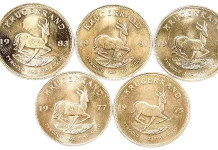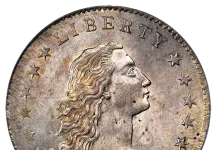
Memorializing a Presidency Cut Short
The attempt on former U.S. President Donald Trump’s life at a campaign event in Butler County, Pennsylvania, on July 13, 2024, could have been more significant than it was. Trump’s ear was clipped, but the 45th president survived.
The last time a sitting or former U.S. president survived an attempted assassination was in 1981, when a man obsessed with actor Jodie Foster shot the recently inaugurated President Ronald Reagan, who survived the attack. Sadly, there was no similar good fortune for President John F. Kennedy nearly 20 years earlier. One of the darkest days in American history occurred on Nov. 22, 1963, when a lone gunman drew his weapon and assassinated President Kennedy during a motorcade procession in Dallas, Texas.

The world changed forever and so did American numismatics.
Just hours after President Kennedy’s murder, U.S. Mint Director Eva B. Adams called Chief Engraver Gilroy Roberts informing him that there was consideration to honor the late president on a large silver coin. JFK’s widow, Jacqueline Kennedy, preferred placing the president’s bust on the half dollar, saying she did not want to displace the first U.S. President, George Washington, from the quarter. This meant usurping Benjamin Franklin from the half dollar, where his visage had been seen since 1948. The move necessitated legislative approval, as redesigning a coin fewer than 25 years since its previous redesign requires an act of Congress.

As legislative wheels turned, design work for the Kennedy half dollar moved ahead. Tight deadlines inspired U.S. Mint Chief Engraver Gilroy Roberts and sculptor-engraver Frank Gasparro to borrow from their respective earlier works featuring Kennedy. The obverse parlays Roberts’ bust of Kennedy from a presidential series medal and the reverse resurrects Gasparro’s Great Seal motif from a 1962 JFK appreciation medal.
One of the darkest days in American history occurred on Nov. 22, 1963, when a lone gunman drew his weapon and assassinated President John F. Kennedy during a motorcade procession in Dallas, Texas. The world changed forever and so did American numismatics.”
In early December 1963, Texas Rep. Henry Gonzalez formally introduced a congressional bill proposing the late President Kennedy be featured on the half dollar. President Lyndon B. Johnson asked Congress to pass the bill, which was signed into law on Dec. 30, 1963.
The first dies were completed on Jan. 2, 1964, with proofs struck first. Circulation strikes followed at the Denver Mint on Jan. 30, 1964, with Philadelphia following suit a few days later. Both the Philadelphia and Denver Mint held a ceremonial first strike on Feb. 11, 1964, ahead of the coin’s official release in March of that year.

BORN AMID A NUMISMATIC CROSSROADS
The Kennedy half dollar was released to the public on March 24, 1964. Throngs of onlookers lined the block leading to the Treasury Department’s window in Washington, D.C., hoping to obtain some of the 70,000 Kennedy halves allocated for sale. All of the available Kennedy half dollars were exhausted, even with limits of 40 coins per person. Similar sellouts occurred at banks in Boston, Philadelphia, New York and elsewhere.
U.S. Treasury and Mint officials expected overwhelming demand for the coin, with 91 million slated for production. That figure was increased to 141 million after reports that hoarders were retaining huge numbers of the coin. Some kept the Kennedy half as a memento of the fallen president. Others squirreled away the new coins because of the 90% silver content amid rising silver bullion prices.

Bullion hoarders were also siphoning millions of 90% silver dimes and quarters from circulation as the intrinsic value of these coins began rivaling their face value. A Treasury study recommended silverless coins as the solution, which President Johnson supported and advised Congress to approve. This led to the passage of the Coinage Act of 1965, which mandated a copper-nickel clad composition for the dime and quarter and a 40% silver-clad format for the half dollar.
The future looks bright for the Kennedy half dollar, which is slated to sport a new obverse design of the 35th president in 2026 in commemoration of the nation’s 250th birthday.”
A TREASURED MEMENTO
The Kennedy half dollar continued its run as a 40% silver coin through 1970, with clad strikes coming online in 1971. By this point, the majority of half dollars were either finding life on the Nevada casino circuit or winding up in dresser drawers as keepsakes. But the coin had virtually disappeared from circulation.

An amusing anecdote about the coin comes from the popular TV game show “Let’s Make a Deal.” In one 1974 episode, host Monty Hall offered a $50 cash reward for each half dollar (up to 20) that a woman in the audience might have in her purse. She flashed a confused look, replying, “Half dollars? They don’t make those anymore!” Hall responded, “Well, all I know is I have a bunch of them sitting at home in a jar!”
As millions of Kennedy half dollars languished in homes around the United States, Americans were preparing for the nation’s 200th birthday—the bicentennial—that was coming in 1976. The U.S. Mint held a design contest to select three patriotic designs to grace the reverses of 1976-dated quarters, half dollars and dollars. Artist Seth Huntington won a spot on the half dollar with his motif of Independence Hall in Philadelphia, where the Declaration of Independence was signed. More than a half billion 1776-1976 bicentennial half dollars were struck, marking the last high-water mark for production of the denomination. Mintages plummeted from there, with no halves struck for circulation in 1987. A nearly generation-long hiatus on circulation-strike half dollars began in 2002.

Circulation strikes were revived once more beginning in 2021, with 13.1 million minted that year and 9.7 million in 2022. In 2023, a total of 58 million were struck: the highest one-year total since 1983, when 66.6 million were produced. This begs the question: Where are all of these new half dollars going? They’re certainly not turning up in cash transactions
at most convenience stores and fast-food joints.
JFK’s widow, Jacqueline Kennedy, preferred placing the president’s bust on the half dollar, saying she did not want to displace the first U.S. President, George Washington, from the quarter. This meant usurping Benjamin Franklin from the half dollar, where his visage had been seen since 1948.”
Theories abound. Perhaps they’re entering circulation in foreign nations, such as Ecuador, El Salvador, the Marshall Islands, Micronesia, Palau, East Timor and Zimbabwe, which recognize U.S. currency as legal tender. Maybe a rush of roll searchers ordering boxes of halves from banks has triggered the Federal Reserve to believe there’s “demand” for half dollars. Or it could be the government has plans to promote the half dollar as a circulating coin again. Official answers seem even scarcer than the appearance of circulating half dollars in the wild at this point.

The future still looks bright for the Kennedy half dollar, which is slated to sport a new obverse design of the 35th president in 2026 in commemoration of the nation’s 250th birthday. Beginning in 2027, the newly redesigned Kennedy half dollar will carry reverse designs featuring the Paralympics, with one new themed design each year through 2030. Even after the Paralympics design program ends, a likeness of Kennedy will remain on the obverse.
The Kennedy half dollar is destined to live into the mid-21st century—and perhaps even beyond.

A VERSATILE COLLECTIBLE
Kennedy half dollars are often considered an affordable series. An entire run of uncirculated business-strike coins from the Philadelphia and Denver Mints can be purchased for around $350. Add in all the satin-finish strikes, such as the scarce 1998-S silver matte strike, and all the silver and clad proofs, including the 1979-S and 1981-S Type I and II mint-mark varieties, and prices for a complete set still hovers south of $1,500.
Beyond buying modern silver proofs, matte strikes and scarce varieties, collectors who want to add a special twist to their sets of Kennedy half dollars may opt for the 2014-W 50th Anniversary Gold Kennedy half dollar. The U.S. Mint released the three-quarter ounce, 24-karat gold coin with much fanfare on Aug. 5, 2014, eventually distributing 73,772, which was near the maximum of 75,000 authorized. Collectors can purchase this coin today for a small sum above its spot value.

Another option for maximizing the challenge—and reward—of collecting Kennedy half dollars is to build a Registry set. The first Set Registry platform was offered by the Professional Coin Grading Service (PCGS), which currently offers nearly two dozen different kinds of set categories geared solely toward Kennedy halves.
Set Registries reward the highest-graded and most complete sets, which influences die-hard and financially well-heeled collectors to pay hand over fist for the highest-graded Kennedy half dollars. This competitiveness and the sheer conditional rarities of some dates have driven astounding results, such as $22,325 for a 1964-D Kennedy half-dollar graded PCGS Mint State-68; $3,760 for a 1978-D graded PCGS Mint State-67+; and $2,585 for a 1993-D graded PCGS Mint State-68.

Does that mean you have to pay thousands of dollars to build a set of Kennedy half dollars? Certainly not. It’s possible to build a set of regular-issue Kennedy half dollars at face value through diligent roll searching. Yes, even silver issues, proofs and pieces not intended for circulation (including the 1970-D as well as the 1987-P and 1987-D coins) have been found by collectors who comb half-dollar rolls from banks.
All this goes to show that at the 60-year mark, Kennedy half dollars offer something for virtually everyone. Does this mean you should try your hand at building a set of Kennedy half dollars? Well, as Kennedy once said, “Every accomplishment starts with the decision to try.” You decide.
VALUABLE VARIETIES
The 1964 Heavily Accented Hair proof half dollar is a vestige of the earliest dies used to strike the first proofs. The Heavily Accented Hair variety reveals thick hairlines above Kennedy’s ear that were softened upon Mrs. Kennedy’s request. All told, fewer than five percent of the 3,950,762 first-year Kennedy proofs exhibit this detail. A Proof-67 example of this one-year-only variety set collectors back by $150 or so. And that’s a far cry from the record price of $46,800 hammered by Heritage Auctions for a Proof-69 Deep Cameo specimen certified by PCGS.

There’s no question that doubled dies are a perennial favorite pursuit for many collectors, and the Kennedy series won’t disappoint in that department. There are multiple attributed doubled dies from the 1960s and 1970s. But the most significant doubled die in the series is a 1974-D emission sporting significant doubling on “IN GOD WE TRUST,” “LIBERTY” and the date. Prices range from $50 to $100 in Choice Uncirculated grades and it can sell for beyond $1,200 in Mint State-66.
Another variety involves lettering—not the doubling thereof, but rather their elimination. Frank Gasparro’s “FG” initials are supposed to appear on the reverse between the eagle’s left leg (viewer’s right) and tail feathers. However, overzealous die polishing led to the initials being completely absent on some coins, resulting in so-called “No FG” halves.

A handful of issues are attributed with the “No FG” variety. The earliest of these is the 1966 No FG strike that appeared in some Special Mint Sets (SMS). The 1966 SMS No FG half retails for $250 to $300, with one example graded Specimen-67 by PCGS landing $2,820 in a 2019 Heritage Auctions appearance. The rarest date is the 1972-D No FG half dollar, which is decidedly challenging in any grade and trades for $1,500 in Mint State-63. The 1982-D No FG is considerably more affordable, at about $100 in Mint State-65.
Make sure to join COINage on Facebook and subscribe to the free monthly newsletter.











